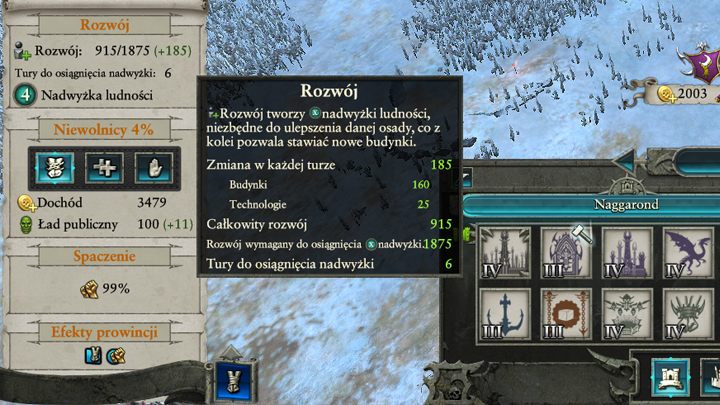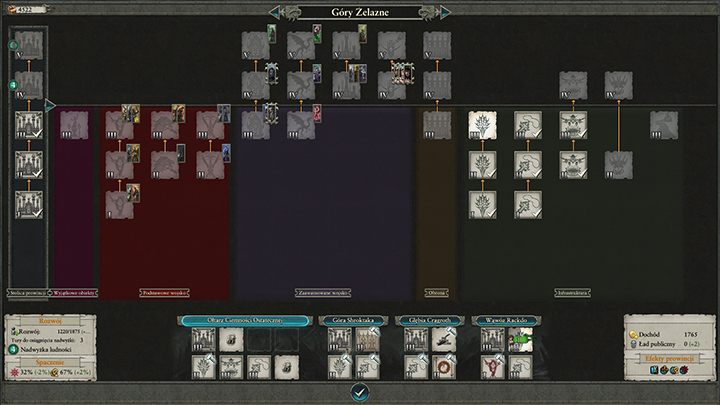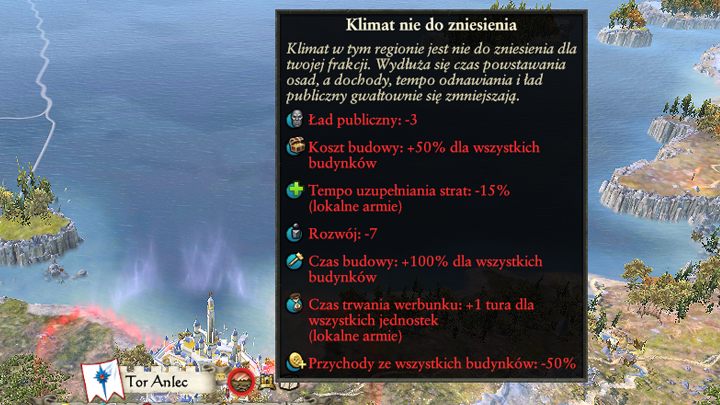Total War Warhammer 2: Settlement development and province climate
Last update:
Developing the provinces by expanding the settlements is absolutely critical to your success. Constructing buildings allows you to recruit armies and then to be able to finance them. Each of the default factions begins the game with only one city - the capital of the province. You should focus on developing and defending this single city - it's the heart of your future empire, and it will be one of the targets of the ritual attacks.
This chapter includes information on the way the provinces work as well as some advice on developing them.
- Developing settlements
- Province capital and smaller settlements
- Types of buildings and their upgrades
- Province climate
Developing settlements

You need to things to develop settlements - gold and population surplus. You get gold as income from settlements as well as from looting settlements and completing quests. Gold is needed not only to develop your cities, but also to recruit new armies, to perform different actions with your agents, to carry out different diplomatic moves or to unlock new technologies.
The population surplus is used to upgrade the main building in the city. It derives from the province development that takes place each turn. After you reach a certain level of development, you will get one population surplus point. Both the pace of the development and the number of population surplus points are uniform across all settlements in the province. The exact information on the pace of development is available after hovering over the development icon in the bottom-left corner.
Each new level of the main building will require more surplus points. The third level requires 2 points, the fourth - 4, and the fifth - 5.
The development rate of your provinces is dependant on a few things:
- The buildings in the province's settlements.
- Unlocked technologies.
- The commandments issued in the province - available if you control every settlement in the province.
- The abilities of Lords and Heroes that are staying in the province.
- Public order.
- Random events that may modify the rate of development for a few turns.
As we've already mentioned, the surplus points are used to develop the main building in the settlement. This provides the following advantages:
- Access to new buildings, and higher building levels.
- Unlocking new building slots.
- Increased city income.
- Increased income from all buildings in the province and in neighboring provinces - only in case of the province capital.
- Stronger garrison.
These bonuses might be a bit different for different races (for example, upgrading the province capital when playing the Skaven doesn't provide any bonus to the other buildings). Additionally, some important cities have their own, unique bonuses (for example Lothern has higher public order).
Province capital and smaller settlements

Each province consists of a couple of cities (usually from 2 to 4 settlements - there are some provinces that only have once city). When you select any of the cities, you will see the tab of all cities of the province, along with the information about who owns them, what buildings are there etc.
There are two types of cities in a province - the capital and regular cities. The capital is on the left of the province tab. The differences here are quite substantial:
- The province capital can be upgraded up to 5th level - reaching it will allow you to construct there any building and upgrade it to its maximal level (which is mostly important in the case of military buildings). There's a total of 7 building slots, apart from the main building, and the most important cities have 9 slots. The capitals also have defense walls by default and have a stronger garrison than the next city, which means they're much harder to conquer; siege engines are mandatory.
- Smaller settlements can only be upgraded to level 3, which means you won't be able to construct certain buildings there. They also have a smaller garrison and battles for these are just regular field battles - the defense of these towns can be improved by erecting city walls.
Since the population surplus grows rather slowly, you should plan the development well and remember about upgrading those buildings that let you develop faster. Otherwise, you might end up with a lot of money, but too few surplus points.
Types of buildings and their upgrades

The province development is almost identical for every faction, with the only difference being the set of available buildings, You will always need gold and population surplus to develop the main building in the settlement, which will unlock more slots and building levels - you will need just gold to upgrade any other building. It's very important to have all your buildings upgraded to their highest available level, so that you're able to use them to their fullest potential. When constructing buildings, keep in mind the type of the settlement you're building them in - making a mistake may mean that you will need to discard a building and construct it anew in another town.
First, however, let's talk about the types of buildings and see which settlements are best for them:
- Basic military - these buildings allow you to recruit basic military units (Spearmen or Lothern Sea Guards in case of the High Elves). These buildings can only be upgraded up to level 3, so you can build them pretty much anywhere.
- Advanced military - these buildings let you recruit more sophisticated military units, as well as specialized units and heroes (including mages). Since you can only access these buildings on the settlement's 3rd level, you should only construct these in capitals - otherwise they're quire literally useless.
- Defense - here we basically have just one building available, which, however, works differently in minor and major settlements. In smaller towns, it significantly improves the garrison and adds city walls (available only on the 3rd settlement level) - in case of province capitals, it only expands the garrison. You will also always a special defensive ability that you will be able to use when defending a siege. These buildings should first of all be erected in towns that are in dangerous areas.
- Infrastructure - the buildings in this category can be divided into two categories. Those that increase the town's development and income can be upgraded only up to level 3, so you should build them in smaller settlements, especially those buildings that generate development. The buildings that increase public order and others, more specialized buildings should be constructed in the capitals, where they can reach their top levels.
- Resources - these buildings should always stand in those settlements, in which they can be found by default. They will yield both the resources needed for trade as well as just give you a boost of income or other bonuses. You should mind these bonuses - if a province has many pastures, you should build a stable there as well.
- Special objects - the above rule applies here too - if one is available in the city, you should spare a slot for it. These buildings yield different bonuses and they're available in the significant metropolises of the Warhammer world.
When constructing new buildings, you should remember not to build the same military buildings in the same province. Wealth, on the other hand, is a different matter, and it accumulates over different buildings, so you can go ahead and erect the same economic buildings.
Construct the buildings you need. You don't need a military building in every province. If the given province is rather safe and you don't need to recruit armies there, you should use all the slots for economy.
Check which buildings decreased the corruption levels. Almost all races suffer if they're under the influence of corruption (apart from the Skaven; the public order plummets and, in extreme cases, your armies become decimated. You should hence consider constructing such buildings even if you don't need the units they allow to create.
Province climate

Contrary to Total War: Warhammer, here, all factions can settle in any province. However, each province has a specific climate, and each race has its preferences regarding this matter - settling in the provinces that don't match these requirements will imply some penalties, such as slower development, lower public order or higher construction costs. The provinces have a small icon signifying their climate next to their names, and the color surrounding this icon tells you how suitable it is for your race. There are three degrees here:
- Suitable - green (no penalties)
- Not suitable - orange (low penalties)
- Uninhabitable - red (high penalties)
Hover the mouse over the climate icon to learn more about the penalties.
- Total War: Warhammer II Game Guide
- Total War Warhammer 2: Game Guide
- Total War Warhammer 2: Campaign Map Gameplay
- Total War Warhammer 2: Choosing Faction
- Total War Warhammer 2: Interface
- Total War Warhammer 2: World Exploration
- Total War Warhammer 2: Settlement development and province climate
- Total War Warhammer 2: Controlling Public Order and Corruption
- Total War Warhammer 2: Diplomacy and Trade
- Total War Warhammer 2: Rituals and Eagle Gates
- Total War Warhammer 2: Controlling the Great Vortex
- Total War Warhammer 2: Campaign Map Gameplay
- Total War Warhammer 2: Game Guide
You are not permitted to copy any image, text or info from this page. This site is not associated with and/or endorsed by the developers and the publishers. All logos and images are copyrighted by their respective owners.
Copyright © 2000 - 2025 Webedia Polska SA for gamepressure.com, unofficial game guides, walkthroughs, secrets, game tips, maps & strategies for top games.
